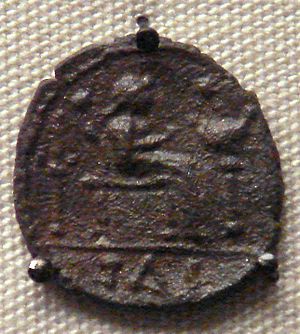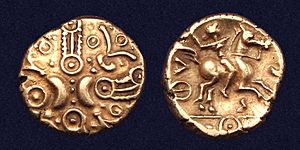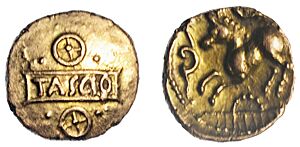Tasciovanus facts for kids

Tasciovanus was an important king of the Catuvellauni tribe in ancient Britain. He ruled before the Romans took over Britain. He likely died around 9 AD.
Contents
Who Was Tasciovanus?
We know about Tasciovanus mostly from the coins he made. These coins are like little pieces of history! He became king of the Catuvellauni around 20 BC. His main city was called Verlamion, which is where the city of St Albans is today.
He might have moved his tribe's main city to Verlamion from an older place nearby. For a short time, between 15 and 10 BC, he even made coins in Camulodunum (Colchester). This suggests he might have taken over that city from another king named Addedomarus.
Tasciovanus's Coins
After his time in Camulodunum, Tasciovanus went back to making coins in Verlamion. Some of his coins have the word "RICON" on them. This word comes from an old British language and means "great king" or "divine king."
Some coins also have other short names like "DIAS," "SEGO," or "ANDOCO." These might have been the names of other rulers who worked with Tasciovanus. Or, they could have been marks showing where the coins were made.
His Family and Successors
Tasciovanus died around 9 AD. His son, Cunobeline, became the next king. Cunobeline mostly ruled from Camulodunum. Another of Tasciovanus's sons, named Epaticcus, expanded their kingdom even further west.
Old Stories About Tasciovanus
People in the Middle Ages told stories about Tasciovanus. One old Welsh book from that time has a family tree. It says "Caratacus, son of Cunobelinus, son of Tasciovanus." This shows the correct order of these kings, even though the story itself might not be fully accurate. It means people remembered them for a very long time!
Tenvantius in Legends
A famous writer named Geoffrey of Monmouth wrote a book called Historia Regum Britanniae in 1136. In this book, Tasciovanus appears as a legendary king named Tenvantius. He is said to be the son of King Lud.
When his father died, Tenvantius and his older brother were too young to rule. So, their uncle, Cassivellaunus, became king of Britain. Tenvantius was made the Duke of Cornwall. He even helped his uncle fight against the famous Roman general Julius Caesar.
Later, when Cassivellaunus died, Tenvantius became the king of Britain. His son, Kimbelinus (who was Cunobeline), then became king after him.



